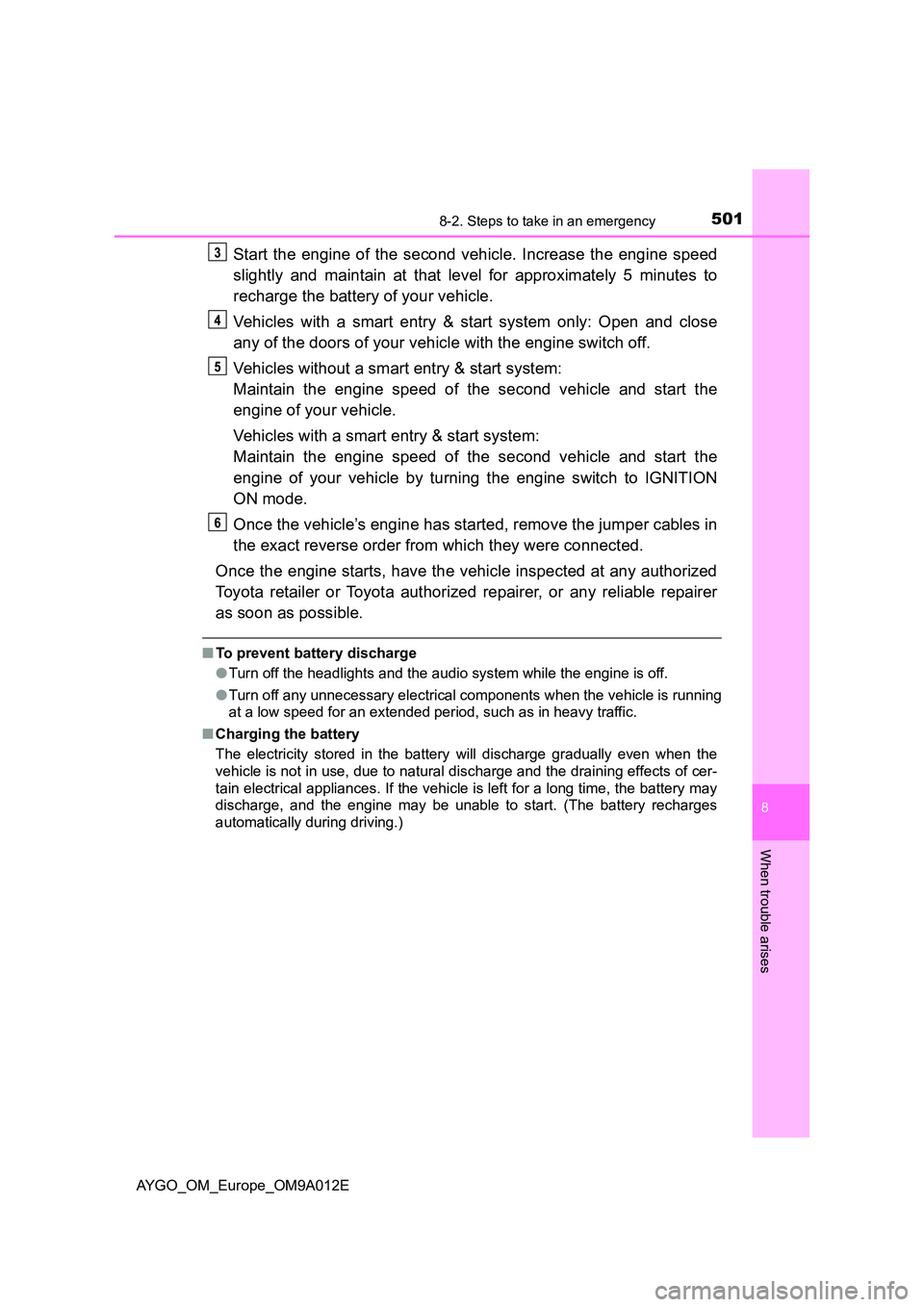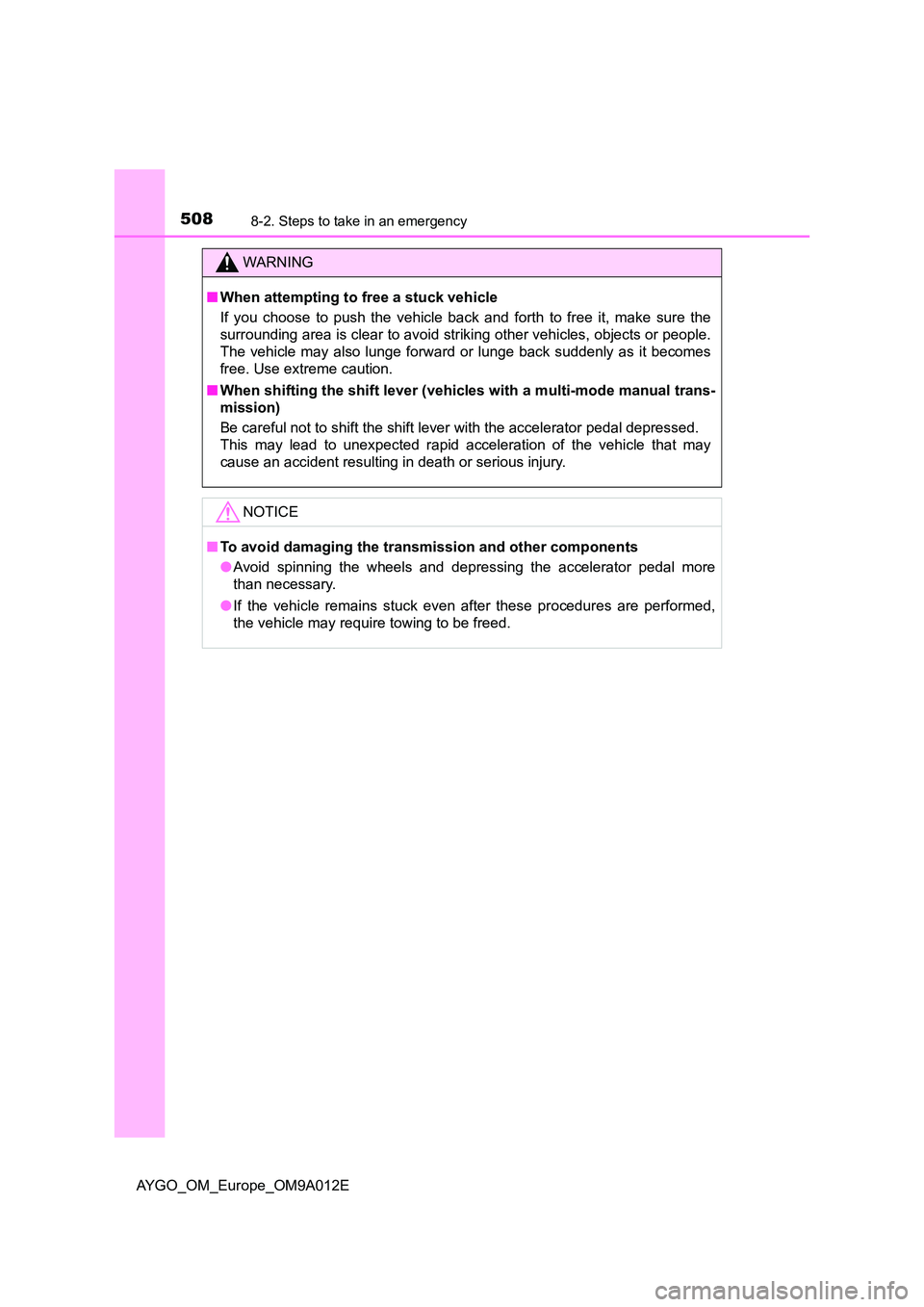2021 TOYOTA AYGO ECO mode
[x] Cancel search: ECO modePage 501 of 546

4998-2. Steps to take in an emergency
8
When trouble arises
AYGO_OM_Europe_OM9A012E
■Stopping the engine
Shift the shift lever to N and press the engine switch as you normally do when
stopping the engine.
■ Replacing the key battery
As the above procedure is a temporary measure, it is recommended that the
electronic key battery be replaced immediately when the battery is depleted.
( P. 415)
■ Changing engine switch modes
Release the brake pedal (multi-mode m anual transmission) or clutch pedal
(manual transmission) and press t he engine switch in step above.
The engine does not start and modes will be changed each time the switch is
pressed. ( P. 219)
■ When the electronic key does not work properly
● Make sure that the smart entry & start system has not been deactivated in
the customization setting. If it is off, turn the function on.
(Customizable features: P. 523)
● Check if battery-saving mode is set. If it is set, cancel the function.
( P. 146)
Page 503 of 546

5018-2. Steps to take in an emergency
8
When trouble arises
AYGO_OM_Europe_OM9A012E
Start the engine of the second vehicle. Increase the engine speed
slightly and maintain at that level for approximately 5 minutes to
recharge the battery of your vehicle.
Vehicles with a smart entry & start system only: Open and close
any of the doors of your vehicle with the engine switch off.
Vehicles without a smart entry & start system:
Maintain the engine speed of the second vehicle and start the
engine of your vehicle.
Vehicles with a smart entry & start system:
Maintain the engine speed of the second vehicle and start the
engine of your vehicle by turning the engine switch to IGNITION
ON mode.
Once the vehicle’s engine has started, remove the jumper cables in
the exact reverse order from which they were connected.
Once the engine starts, have the vehicle inspected at any authorized
Toyota retailer or Toyota authorized repairer, or any reliable repairer
as soon as possible.
■ To prevent battery discharge
● Turn off the headlights and the audio system while the engine is off.
● Turn off any unnecessary electrical components when the vehicle is running
at a low speed for an extended period, such as in heavy traffic.
■ Charging the battery
The electricity stored in the battery will discharge gradually even when the
vehicle is not in use, due to natural discharge and the draining effects of cer-
tain electrical appliances. If the vehicle is left for a long time, the battery may
discharge, and the engine may be unable to start. (The battery recharges
automatically during driving.)
Page 504 of 546

5028-2. Steps to take in an emergency
AYGO_OM_Europe_OM9A012E
■ Precautions when the battery is discharged (vehicles with a smart entry
& start system)
● In some cases, it may not be possible to unlock the doors using the smart
entry & start system when the battery is discharged. Use the wireless
remote control or the mechanical key to lock or unlock the doors.
● The engine may not start on the first attempt after the battery has recharged
but will start normally after the second attempt. This is not a malfunction.
● The engine switch mode is memorized by the vehicle. When the battery is
reconnected, the system will return to the mode it was in before the battery
was discharged. Before disconnecting the battery, turn the engine switch off.
If you are unsure what mode the engine switch was in before the battery dis-
charged, be especially careful when reconnecting the battery.
■ When replacing the battery
● Use a battery that conforms to European regulations.
● Use a battery with the same case size as the previous one;
vehicles without cold area specifications or a stop & start system: (LN0),
20 hours rate capacity (20HR) is equiva lent (35Ah) or greater, and perfor-
mance rating (CCA) is equivalent (300A) or greater;
vehicles with cold area specifications: (LN0), 20 hours rate capacity (20HR)
is equivalent (42Ah) or greater, and performance rating (CCA) is equivalent
(390A) or greater; or
vehicles with a stop & start system: (LN2), 20 hours rate capacity (20HR) is
equivalent (60Ah) or greater, and performance rating (CCA) is equivalent
(540A) or greater.
• If the sizes differ, the battery cannot be properly secured.
• If the 20 hour rate capacity is low, even if the time period where the vehi-
cle is not used is a short time, the battery may discharge and the engine
may not be able to start.
● For details, consult any authorized Toyota retailer or Toyota authorized
repairer, or any reliable repairer.
Page 509 of 546

5078-2. Steps to take in an emergency
8
When trouble arises
AYGO_OM_Europe_OM9A012E
If the vehicle becomes stuck
Stop the engine. Set the parking brake and shift the shift lever to N.
Remove the mud, snow or sand from around the stuck tire.
Place wood, stones or some other material to help provide traction
under the tires.
Restart the engine.
Shift the shift lever to E, M or R (multi-mode manual transmission)
or 1 or R (manual transmission) and release the parking brake.
Then, while exercising caution, depress the accelerator pedal.
■ When it is difficult to free the vehicle
Press to turn off TRC.
Turn off TRC and/or VSC if these functions are hampering your attempts to
free the vehicle. ( P. 280)
■ Emergency hooks
Carry out the following procedures if the tires spin or the vehicle
becomes stuck in mud, dirt or snow:
When your vehicle becomes stuck and
cannot move, the emergency hooks are
used for another vehicle to pull your
vehicle to pull your vehicle out in an
emergency.
Your vehicle is not designed to tow
another vehicle.
Page 510 of 546

5088-2. Steps to take in an emergency
AYGO_OM_Europe_OM9A012E
WARNING
■When attempting to free a stuck vehicle
If you choose to push the vehicle back and forth to free it, make sure the
surrounding area is clear to avoid striking other vehicles, objects or people.
The vehicle may also lunge forward or lunge back suddenly as it becomes
free. Use extreme caution.
■ When shifting the shift lever (vehicles with a multi-mode manual trans-
mission)
Be careful not to shift the shift lever with the accelerator pedal depressed.
This may lead to unexpected rapid acceleration of the vehicle that may
cause an accident resulting in death or serious injury.
NOTICE
■ To avoid damaging the transmission and other components
● Avoid spinning the wheels and depressing the accelerator pedal more
than necessary.
● If the vehicle remains stuck even after these procedures are performed,
the vehicle may require towing to be freed.
Page 535 of 546

533Alphabetical index
AYGO_OM_Europe_OM9A012E
Electric Power Steering
(EPS) ....................................... 279
Function ................................ 279
Warning light ......................... 451
Electronic key .......................... 112
Battery-saving function ......... 146
If the electronic key does not
operate properly ................. 497
Replacing the battery ............ 415
Emergency, in case of
If the electronic key does not
operate properly ................. 497
If the engine will not start ...... 494
If the shift lever cannot be
shifted ................................. 496
If the vehicle has discharged
battery................................. 500
If the vehicle is trapped in
rising water ......................... 441
If the warning buzzer
sounds ................................ 449
If the warning light
turns on............................... 449
If you have a flat tire...... 459, 481
If you lose your keys ............. 114
If you think something is
wrong .................................. 447
If your vehicle becomes
stuck ................................... 507
If your vehicle needs to be
towed .................................. 442
If your vehicle overheats ....... 504
Emergency brake signal ......... 279
Emergency flashers................. 438
Emergency tire puncture
repair kit ................................. 459Engine
“ACC” position ...................... 214
Accessory mode ................... 219
Compartment ........................ 393
Engine switch................ 214, 217
Hood ..................................... 390
How to start
the engine................... 214, 217
If the engine will not start ...... 494
Ignition switch
(engine switch) ........... 214, 217
Overheating .......................... 504
Engine coolant ......................... 397
Capacity ................................ 515
Checking ............................... 397
Preparing and checking
before winter....................... 285
Engine coolant
temperature
warning light .......................... 450
Engine immobilizer system ...... 75
Engine oil ................................. 394
Capacity ................................ 512
Checking ............................... 394
Preparing and checking
before winter....................... 285
Engine switch
(ignition switch)............. 214, 217
EPS (Electronic Power
Steering)................................. 279
Function ................................ 279
Warning light ......................... 451
E
Page 541 of 546

539Alphabetical index
AYGO_OM_Europe_OM9A012E
Sensor
Automatic headlight
system ................................ 233
LDA
(Lane Departure Alert) ........ 246
PCS (Pre-Collision
system) ............................... 246
Service reminder indicators ..... 98
Shift lever
If the shift lever cannot be
shifted ................................. 496
Manual transmission ............. 227
Multi-mode manual
transmission ....................... 222
Shift lock system ..................... 496
Shopping bag hooks ............... 371
Side airbags ............................... 36
Side mirrors.............................. 192
Adjusting and folding............. 192
Side turn signal lights ............. 229
Replacing light bulbs ............. 435
Turn signal lever ................... 229
Smart entry & start system ..... 143
Antenna location ................... 143
Entry functions .............. 133, 137
Starting the engine ................ 217
Warning light ................. 453, 457Snow tires ................................ 287
Spare tire .................................. 481
Inflation pressure .................. 518
Storage location .................... 482
Specifications .......................... 510
Speed limiter ............................ 269
Speedometer ............................ 103
Steering lock .................... 215, 220
Steering lock system
warning light ....................... 458
Steering wheel ......................... 189
Adjustment ............................ 189
Audio switches ...................... 292
Stop & Start system ................ 272
Stop/tail lights
Replacing light bulbs............. 432
Wattage ................................ 520
Storage feature ........................ 367
Stuck
If the vehicle becomes
stuck ................................... 507
Sun visors ................................ 373
*: For vehicles with a multimedia system, refer to “Multimedia owner’s manual”.